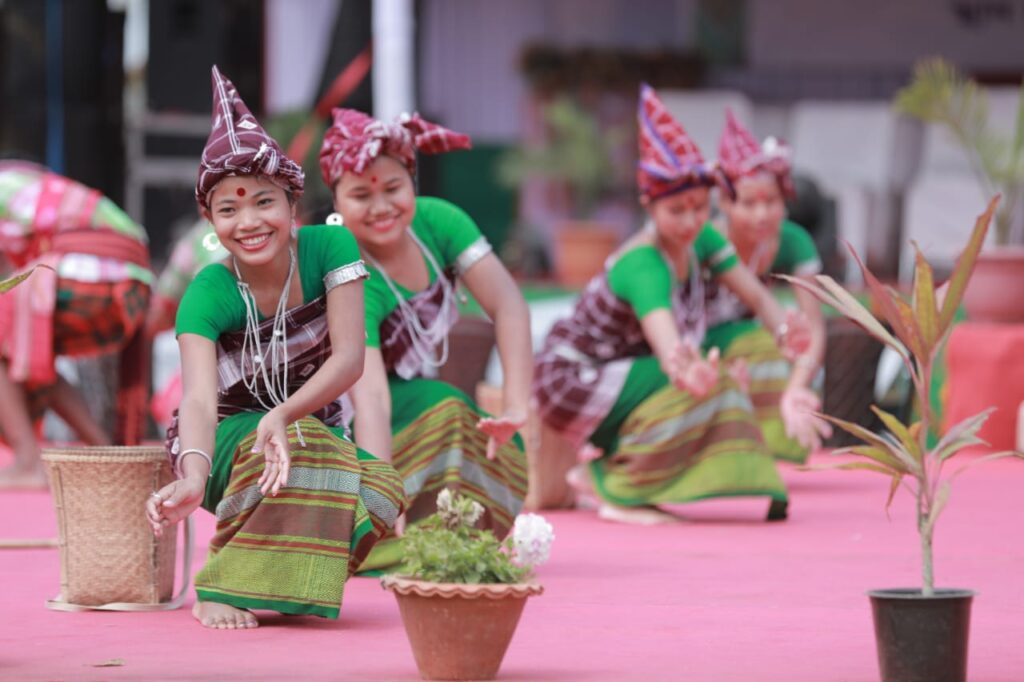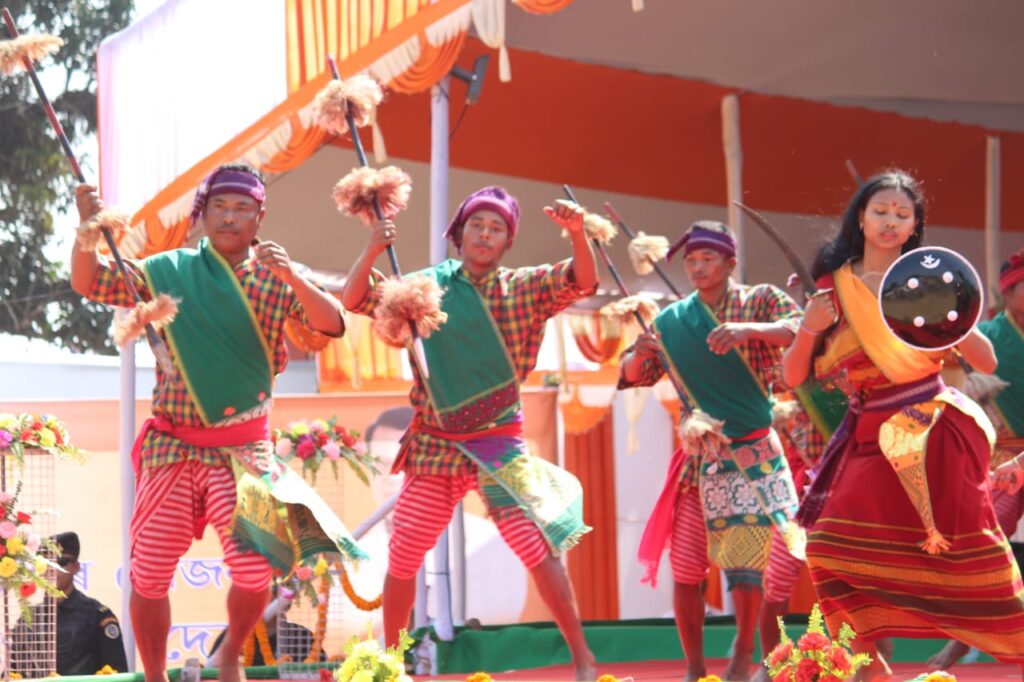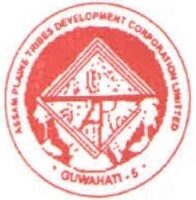Tribes are not to be trifled with. Your ability to thrive depends on the tribe.”
― Scott Perry, Endeavor: Thrive Through Work Aligned with Your Values, Talents, and Tribe
Rabha Tribes
The Rabha is a Tibeto-Burman community indigenous to the Indian states of Assam, Meghalaya, and West Bengal. They primarily inhabit the plains of Lower Assam and the Dooars, while some are found in the Garo Hills. Most of the Rabhas of Dooars refer to themselves as Rabha, but some of them often declare themselves as Kocha. The Rabha community has a rich, multi-faceted, and distinct culture of its own. The agricultural practices, food habits, and belief systems of the Rabhas reflect a conglomeration of features from both the Aryan and Mongoloid culture. The Rabha society is matrilineal. The village economy is based on agriculture and both men and women work in the fields. The women love to wear colorful clothes that they weave themselves and they wear a lot of beads and silver ornaments. The Rabhas are non-vegetarians and rice is their staple food.



Barman Tribes
The Barman Kacharis are an indigenous community of Northeast India and are a subsection of the Dimasa people in Barak Valley but claim to be a separate group in Brahmaputra Valley. They are mainly found in the districts of Lower Assam and in Barak Valley like Hailakandi and Karimganj and some parts of Arunachal Pradesh.
Boro-Kachari Tribes
Boros are officially identified as “Boro, Boro-Kachari” scheduled tribe under the Constitution of India. Boros speak the Boro language, a Boro-Garo language of the Tibeto-Burman family, which is recognized as one of the twenty-two Scheduled languages of India. Over two-thirds of the people are bilingual, speaking Assamese as a second language. The Boro along with other cognate groups of Bodo-Kachari peoples are prehistoric settlers who are believed to have migrated at least 3000 years ago. The Bodo-Kachari were also some of the first people to rear silkworms and produce silk material and were considered to be advanced in rice cultivation in Assam during this time period. Boros have mostly settled farmers, who have traditional irrigation, dong. The Boro people are recognized as a plains tribe in the Sixth Schedule of the Indian Constitution and have special powers in the Bodoland Territorial Region, an autonomous division; and also as a minority people.
Deori Tribes
The Deoris are one of the major indigenous communities of Assam and Arunachal Pradesh. and are commonly associated with the Bodo-Kachari group. They historically lived in the area of Sadiya, Joidaam, Patkai foothills, and in the upper plains or also called the hinterland of the Brahmaputra Valley. Concrete documented records about the history of the tribe are very limited. Scanty information was found in few books and official records. The Deori community belongs to the Sino-Tibetan language family. In ancient times, the Deoris served as priests of the Chutia community. In the British census reports, the Deoris were termed as Deori-Chutias. The community has maintained its racial traits, language, religion, folktales, and traditional beliefs through the centuries. They were divided into Jimochayan/ Dibang-Diyongial(Dibongia), Midoyan/Tengapania, Luitugan/Borgoya. The native language is retained only by the Dibongia group.
Garo Tribes
The Garos are a Tibeto-Burman ethnic group from the Indian subcontinent, notably found in the Indian states of Meghalaya, Assam, Tripura, Nagaland, and some neighboring areas of Bangladesh, notably Madhupur, Mymensingh, Netrokona, Jamalpur, Sherpur and Sylhet, Rangamati who call themselves A·chik Mande(literally “hill people,” from a·chik “bite soil” + mande “people”) or simply A·chik or Mande – the name “Garo” being given to them and used by non-Garos. Historically, the Garo name was used for a wide range of people in the southern bank of Brahmaputra but today, Garo means Hill tribes who call themselves A’chik Mande. They are the second-largest tribe in Meghalaya after the Khasi and comprise about a third of the local population. The Garos are one of the few remaining matrilineal societies in the world.
Hajong Tribes
The Hajongs belong to the Bodo-kachari group of tribes, native to the Indian Subcontinent. They are one of the least studied endogamous Bodo-Kachari tribes having a trans-border international presence in Northeastern India and Bangladesh. The Hajongs have no recorded history and whatever historical references available are in the form of legends, folktales, and traditional beliefs. Therefore, in terms of their origin and migration very little is known; although some mention is made to this effect in both the district gazetteers of Garo Hills and Mymensingh. In the section on Garo Hills in Assam District Gazetteer by B.C. Allen (1906) it is mentioned that the hajongs belong to the Indo-Tibetan group of the main Mongoloid race. They had come from the Tibetan plateau, modern-day Qinghai, to north-eastern India and Assam along the Brahmaputra and Teesta rivers and their tributaries and had spread out in this area.
Sonowal Kachari Tribes
The Kachari Sonwal or Sonowal are indigenous people who live in northeast India. They are a subgroup of the larger Kachari tribe. The name Sonwal comes from the word for gold. The traditional occupation of the Sonwal was panning for gold during the Ahom kingdom. Today the Sonowal are primarily engaged in agriculture. They grow rice, betel nut, sweet potatoes, and cotton. Betel nut is a mild stimulant chewed in social situations. Sonowal women are expert weavers of cotton and every young woman is given a handloom upon her marriage. The Sonowal also raises poultry and has cattle for dairy products. The Sonowal is believed to have a very rich traditional knowledge of indigenous medicine.
Tai Khamti Tribes
The Tai Khamti, or simply Khamti as they are also known, are a Tai ethnic group native to the Hkamti Long, Mogaung, and Myitkyina regions of Kachin State as well Hkamti District of Sagaing Division of Myanmar. In India, they are found in the Namsai district and Changlang district of Arunachal Pradesh. Smaller numbers are present in the Lakhimpur district, Dhemaji district, and Munglang Khamti village in the Tinsukia district of Assam and possibly in some parts of China. Khamtis has a population of 100,031 out of which 40,005 live in Arunachal Pradesh and 60,026 in Assam. However, in Myanmar, their total population is estimated at 200,000 people.
Tiwa Tribes
Tiwa(Lalung) is an ethnic group mainly inhabiting the states of Assam and Meghalaya in northeastern India. They are also found in some areas of Arunachal Pradesh, Manipur, and Nagaland. They are recognized as a Scheduled tribe within the State of Assam. They were known as Lalungs in the Assamese Buranjis and in Colonial literature and in the Constitution of India, though members of the group prefer to call themselves Tiwa (meaning “the people who were lifted from below”). Some of their neighbors still call them Lalung. A striking peculiarity of the Tiwa is their division into two sub-groups, Hill Tiwa and Plains Tiwas, displaying contrasting cultural features.
Mech Tribes
The Mech (spelled Meche in Nepal; pronounced /mes/ or /meʃ/) is an ethnic group belonging to the Bodo-Kachari group of peoples. It is one of the scheduled tribes of India, listed both in West Bengal and Assam, India. It has been suggested that mech is probably a corruption of the Sanskrit word mlechchha. Nevertheless, Stuart N. Wolfenden observed that some people do self-designate as Mech, So, he reconstructed Mech from Tibeto-Burman root “mi” means “man”. Other authors have speculated that Meche is derived from the Mechi river because the Bodo-Kachari peoples in Nepal had settled around it; Mecha a region of the Bod country; and descendants of Mechel a legendary figure of Nepal.
Mising Tribes
The Mising, sometimes called Miri, is an indigenous community inhabiting parts of the Indian states of Assam and Arunachal Pradesh. They were also known as Miris in the past and are still recognized as Miris in the Constitution of India. Misings are recognized as a Scheduled Tribe by the Indian government under the name ‘Miri’. Their language, Mising, is part of the Tani branch of the Sino-Tibetan family.
Singpho Tribe
The Singpho tribe is the tribe that inhabits parts of India, China, and Myanmar. In India, Singpho Tribe is located in the state of Arunachal Pradesh in the district of Lohit and Changlang and in Assam. They live in the district of Tinsukia and spread in some other districts like Sivasagar, Jorhat, and Golaghat. Consist of a population of at least 7,200 in India, usually they live in the villages, namely Bordumsa, Miao, Innao, N-hpum, Namgo, Ketetong, Pangna, Phup, N-htem, Mungong, Kumchai, Pangsun, Hasak, Katha, Bisa, Dibong, Duwarmara, Namo and Namsai, etc. The Singpho are the same people as those called the Kachin in Burma and the Jingpo in China. They speak the Singpho dialect of the Jingpo language.
